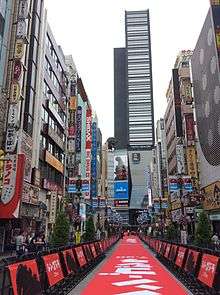Kabukichō, Tokyo

Kabukichō (歌舞伎町) is an entertainment and red-light district in Shinjuku, Tokyo, Japan. Kabukichō is the location of many host and hostess clubs, love hotels, shops, restaurants, and nightclubs, and is often called the "Sleepless Town" (眠らない街). The district's name comes from late-1940s plans to build a kabuki theater: although the theater was never built, the name stuck.
The area has many movie theaters, and is located near Shinjuku Station, Seibu Shinjuku Station, and several other major railway and subway stations.
History
Originally, the area was known as Tsunohazu (角筈) and was a swamp. After the Meiji Period, the area became a duck sanctuary. As the Yodobashi Purification Plant was built in 1893, the ponds were filled in. In 1920, a girls' school was built there, and the surroundings were developed into a residential area. During World War II, the bombing of Tokyo in 1945 razed the area to the ground. After the war, a kabuki theatre was planned to be built there and the town changed its name to Kabukichō. Though the theatre was cancelled due to financial problems, the name remained. Kabukichō was quickly redeveloped after the war, mainly due to the efforts of the overseas Chinese in Japan who bought land left unused after the expos and greatly developed them. Examples of such people include the founder of Humax, Lin Yiwen, who started his business with a cabaret.
At present, Kabukichō has transformed from a residential area to a world-famous red-light district housing over three thousand bars, nightclubs, love hotels, massage parlours, hostess clubs and the like. Although referred here as a "red light district", there are no red lights in the literal sense with prostitutes in the windows as in Amsterdam. Recently, tourism from China and Korea are on the rise, and so, many tourists can be seen in Kabukichō even during daytime.
The Shinjuku Koma Theater has been a landmark in Kabukichō. Now in its third building, it has hosted concerts and other performances by top stars, including enka singers Saburō Kitajima, Kiyoshi Hikawa, and actor Ken Matsudaira. The management announced that they would close after the December 31, 2008 show.[1]
Crime
In 2004, according to a spokesperson of Metropolitan Tokyo, there are more than 1,000 yakuza members in Kabukichō, and 120 different enterprises under their control.[2]
Entering the new millennium, laws were more strictly enforced and patrols became more frequent. These, adding to the installation of fifty closed-circuit cameras in May 2002, reduced criminal activities in Kabukichō, amidst controversy.
In 2004, the police undertook an operation clamping down on illegal clubs and brothels, causing many to go out of business. Also, there is a movement to rid Kabukichō of the yakuza ("bad hand" gangs), known as the Kabukichō Renaissance.
In culture
Kabukichō is featured in a number of media:
- Shinjuku Incident, a 2009 Jackie Chan movie set in the early 1990s about Chinese immigrants in Japan
- Fuyajo, novel by Hase Seishu. Also, a movie based on the novel that was filmed in Kabukichō
- Enter the Void, a film by Gaspar Noé, was partly filmed and set in Kabukichō[3]
See also
- Jūsō, Osaka
- Kyabakura Union
- Tobita Shinchi, Osaka
References
- ↑ 「演歌の殿堂」新宿コマ、今年限りで閉館 (1/2ページ) - MSN産経ニュース (Retrieved May 28, 2008)
- ↑ 2004年1月19日竹花東京都副知事発言・歌舞伎町住民との懇談会
- ↑ "Interview with Gaspar Noé for the A.V. club".
External links
| Wikimedia Commons has media related to Kabukichō, Tokyo. |
- Kabukicho Renaissance official website (English)
- KABUKI町 Kabukicho portal site (Japanese)
- Kabukicho Commune (Japanese)
Coordinates: 35°41′38″N 139°42′12″E / 35.69388°N 139.703422°E